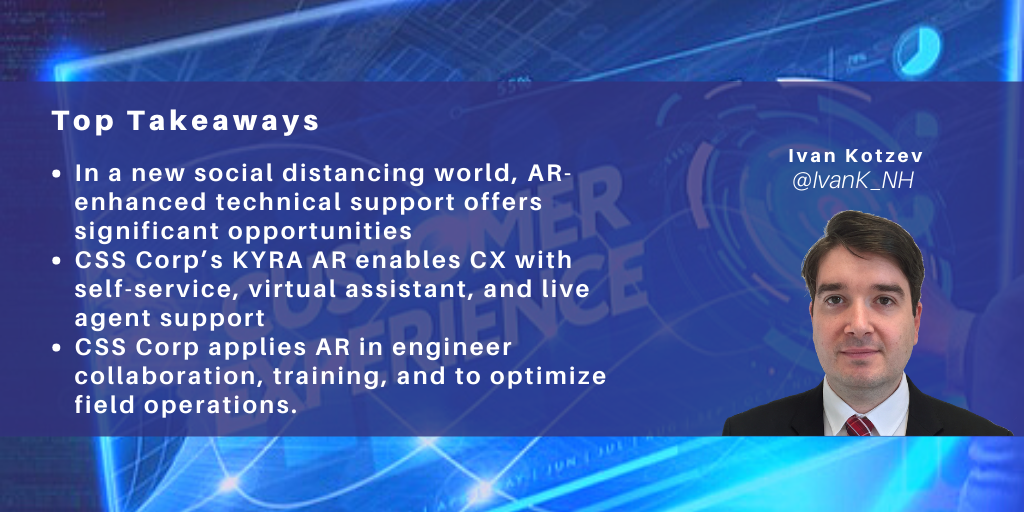Search posts by keywords:
Filter posts by author:
Related NEAT Reports
Other blog posts
posted on May 18, 2020 by Ivan Kotzev

In a new social distancing world, most traditional face-to-face customer service tasks have had to digitize quickly. This trend is not new, but for some processes, it required the adoption of emerging technology and different operational models. A prime example is customer premise visits by engineers for equipment installations, parts replacement, and technical support. For several years, CX services vendors have worked on visual support and remote diagnostics, and are now looking to Augmented Reality (AR) to lift technical support to the next level. CSS Corp has already developed its proprietary technology in the space and is now working on AR deployments.
KYRA: AR-enabled CX & enterprise support
CSS Corp sees AR-enabled CX and support across three use cases:
- Visual self-service, where the AR provides visual guidance to users on product features and interactive how-to user manuals
- AR integrated virtual assistant, which automates the user engagement with intelligent bots using AR projections and overlay
- Remote agent assistance to resolve user issues from a distance with AR markers and overlays.
The company has a pilot of AR visual self-service for a U.S. multinational telecom equipment manufacturer with products in the fixed, wireless, and IP technology space. The AR has step-by-step visual user guides and in-depth installation manuals, component descriptions, component usage instructions, and remote visual troubleshooting. The implementation has an integrated virtual assistant.
The user or field engineer scans a QR code on the packaging leading to the AR support web page downloading an app on their smartphone. She or he then asks the bot for a virtual user guide. The customer focuses their mobile camera on the equipment or error message, and the AR support interface identifies the product model and downloads the correct user guides and knowledge articles. It displays the components and narrates within the AR environment. The virtual assistant explains how to set up and use the components using animations and AR markers. In addition to the spoken and written instructions, it allows image scrolling and freezing and control with voice. The bot then reads the device screen to determine if the installation is successful and guides the user to enter configuration commands.
If the initial installation fails, the computer vision identifies the error message, and the bot starts interacting with the user via chat or messenger to troubleshoot the issue and guide the self-service steps within the AR. If the issue still cannot be resolved, the bot escalates to a live agent who initiates a secure AR session on the support app by sending a link. The transfer displays to the agent the transcript and completed steps and auto-creates a ticket and case history in the client CRM.
For the client, the initial results of the pilot in 2020 show 23% faster issue resolutions for AR supported interactions and 38% AHT reduction with the automation. For 20% of the volumes, the realized end-to-end automation efficiencies reached 94%.
Challenges to the spread of AR
Historically, AR adoption for remote collaboration stumbled due to a lack of high network bandwidth and speed. The proliferation of fiber optic broadband and the rollout of 5G will eventually resolve this challenge. In the meantime, CSS Corp’s KYRA uses cloud-based lightweight AR technology.
Another common concern for all two-way video chat remains security and privacy protection. CSS Corp addresses this issue by masking to the live agent all sensitive user information such as passwords and blurring outside objects. It also ensures that the tools are PCI DSS compliant.
Lastly, customers are often reluctant to download another app, and its usage sharply decreases after the initial setup. Here, CSS Corp works with clients to offer additional incentives and features in the app to drive regular user engagement. It also provides the SMS/email links to user, to start the remote assistance with the agent.
KYRA: AR-optimized field operations
Other opportunities for KYRA, which CSS Corp actively explores, are enabling field engineers with virtual technical assistance in a live environment for remote installations, deployments, repair, and maintenance. An example POC is for a telecom and media brand which struggles with high-volume dispatches for no-fault cases and low fix rate, requiring additional visits in close to a quarter of cases. CSS Corp’s AR proposal includes remote issue resolution, improved due diligence before the dispatch, and remote consultation for the field engineers. It estimates to eliminate 90% of the no-fault dispatches and reduced unscheduled truck rolls by ~25%, resulting in cost savings, improved customer satisfaction, and freeing up technicians’ time.
In addition to managed services, the AR and app technology, the company trains the ML algorithms with real-life drawings and component libraries, and the algorithm annotates issues for self-learning. The company builds process logic and rules and expands the knowledge base articles with rich media content.
AR Future
The future options before AR and VR use in CX are significant, not only because of the growth of AR-capable smartphones, but also the increase of use cases such as testing designs and trying products virtually. The current lockdown has triggered companies to move from innovating to adopting AR. For example, IKEA, a pioneer with its 2013 AR catalog, acquired AR startup Geomagical Labs in April, and British online retailer ASOS launched its own AR tool in May.
CSS Corp believes the technology is an excellent enhancement for remote expert collaboration to guide local technicians by projecting problem resolution for quicker handoff. For communication and information system clients, it integrated the AR with its managed services platform Contelli, mapping clients’ infrastructure and applications.
AR is also applicable for engineer education, with CSS Corp already training its distributed workforce operating in WAH mode with AR simulated environment; for example, for out-of-scope devices.
CSS Corp is now identifying client segments in consumer electronics, networking, and connected environments suitable for AR-boosted technical support.
